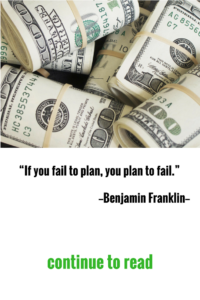How to start a financial safety net recap
“If you fail to plan, you plan to fail.”
—Benjamin Franklin—
I’ve written a series of articles on “How to Start a Financial Safety Net.” I’ve done the best I can to show how you
can take charge of your life by taking charge of your money. you can start at the beginning I know so many people who live
paycheck to paycheck, and they don’t need to. Poor money management has kept them broke for years.
Last week, as I was approaching my car, it looked like I had a tire going flat. After examining the tire, I realized it was just the way the car was sitting. However, I did notice my tires are starting to wear. The tread has worn evenly across all the tires, and there’s no cupping. That indicates I have no reason to believe there are any mechanical problems, but I’m sure I’ll need new tires late this year or early next year.
I know people who have driven on tires with the steel cord exposed. They put themselves (and others) in danger because they couldn’t afford to replace their tires. For them buying tires for their car was a major undertaking. They were faced with the choice of borrowing money or letting the car sit (at least for a while). They chose to borrow. Repaying the loan (with interest) took three years. For thirty-six months, they had to worry about scrimping together a monthly payment. By then, the “new” tires were more than halfway to needing to be replaced—again.
I won’t have to deal with that problem. The money for my new tires is already set aside in our miscellaneous account. The miscellaneous account is where I put money I’m saving for specific items and events: repairs, birthdays, Christmas, vacations, etc. It, also, includes our emergency fund.
The point: I won’t need to worry about putting together the money I need to buy new tires. I won’t need to borrow the money. I’ve already saved it. The purchase of new tires will not impact my day-to-day lifestyle.
I don’t have a high paying job, but the money I earn, I manage. I live by a budget that includes a saving plan. I’ve built and continue to add to a financial safety net. I save rigorously because I don’t want to be responsible for the cost and consequences of borrowed money. debt free
The following is a summary of the articles in this series:
How to start a financial safety net
Start at the beginning, get out of debt and start setting aside money to see you through a hard time. Have a plan—a budget. It’s, certainly, ok to enjoy life now, but circumstances change. Lean financial times are a real possibility. So are “unexpected”(Perhaps unconsidered is a better word?) events. Both can be very real threats to your lifestyle. Determine what is important to your lifestyle. Think about how accident, wear, and loss of these things would—financially—affect you and, therefore, your lifestyle. Building a financial safety net—now—can mitigate the impact of the unexpected. In this series I tell you the things important to my lifestyle and how I’m proactive in protecting them.
Protect your income cash flow
Are you prepared to be unemployed? If you live paycheck to paycheck, you can’t expect to maintain your lifestyle if you’re not working. Unemployment benefits are limited. If you want to preserve your lifestyle, you need to take steps now—while you are working—to save money, and find additional sources of income.
Supplement your health care
Health insurance is expensive. Being without it can be even more expensive. Look into ways to make to make your insurance more effective and consider “insuring” your insurance.
Protect your home
Maybe you own your house. Maybe you are renting your residence. In either case, a disaster like a fire, tornado, or lighting strike can really upset your lifestyle. There are things you can do to minimize the damage to your finances as life returns to normal.
Protect your transportation
You need your car. Not just the vehicle, but the service it provides. More than likely, the chief function of your car is to get you to and from work. It’s essential to your lifestyle, and needs to be protected. Insurance protects your car from accident, but it also needs to be maintained. What good is a vehicle, if it’s in no condition to drive?
Protect everything else
As we live, we all acquire things we “need.” These are things we would sorely miss if we had to do without them. They define our lifestyle. As with everything, they are subject to wear and breakage. If we want to continue to enjoy the convenience and comfort they give, we need to repair or replace them. Since most items have an average usage span, go ahead and prepare for that need.
Conclusion
Living by a financial plan that prevents time or an unexpected event from bankrupting your lifestyle is the first step in preparing a financial safety net. Examine your lifestyle for those things that make it a life you enjoy. Prepare to protect those things. Build a financial safety net recap.

